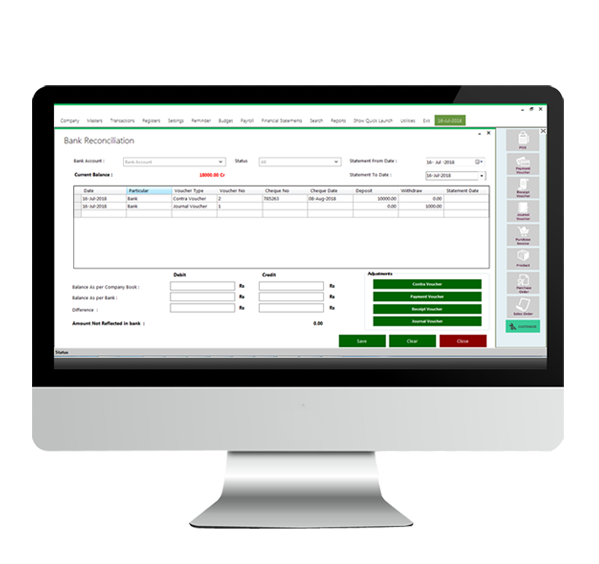✔
Customer Accounts Management - First commandment of accounts receivable: Know thy
customer! And, yes, advanced functionality also allows for custom fields and quick customer creation with records cloning.
✔
Invoice Creation - There are a million and one possible invoice layouts. That’s a scientific fact. Seek
flexibility to present invoices with just the fields you need for shipping, billing, terms, item, and pricing info.

Accounts Receivable and Billing
✔
Custom Accounts Receivable Terms - Every accounts receivable record is really a short term loan. Make sure the Bank of Your Business can easily set the terms and rate of your choice.
✔
AR Aging Reports - Time spares no AR record. Find your receivables senior citizens with due date and issue date aging reports.
✔
Progress Billing - “If there is no struggle, there is no progress.” Same could be said for the
tricky task of progress billing! But advanced AR features make timing invoices and tracking payments easier.
✔
Sales Attributions - To the victor, go the spoils. And to the seller goes the commission. Or
at least the credit. Agent, location, and departmental sales attribution provide performance metrics
and a mechanism for enabling incentive compensation.
✔
Cost of Goods Sold Reporting - Breakdown! Go ahead and give it to me. Granular AR reporting on COGS categories like shipping, handling, taxes, and tariffs, that is.
✔
Account Holds - Sometimes the Bank of Your Business needs to pump the breaks on the deadbeats.
Account hold features prevent delivery of goods to customers unlikely to pay.
✔
AR Comment Support - Bart in shipping called your top customer a mean name, so that’s why you issued that
credit. Things don’t always go as planned. Notate AR exceptions with comments.
✔
Recurring Invoices - The ability to automatically generate invoices for repeating invoices: Now the number
1 recommended approach for preventing carpal-tunnel in AR clerks!
✔
Balance-Forward - Back to the future. Easily move old balances into new invoices with balance forward functionality.
✔
Sales Tax Calculation - Alaska, Delaware, Montana, New Hampshire, & Oregon. They don’t collect sales tax.
The other ones do. So do many municipalities. It’s complicated but easier with automatic calculation tools.
✔
Credit Card Payment Support - If you really want to have fun, try reconciling credit card processor
transaction records with open AR records, said no one. Integration tools make the task quicker and, in some rare cases, automatic.
✔
Invoice Duplication - Same customer ordered the same product as last week? Why not just copy the invoice and make the necessary change or two instead of re-entering every last invoice field?
✔
Envelopes, Receipts, Reminders, Credit Notes, Pack Slips - Because invoices aren’t the only documents that need to be created to fill customer orders.
✔
Estimating and Quoting - Pesky customers always wanting to know what stuff will cost before they buy! Save time by automating the conversion of estimates and quotes into orders and invoices.
✔
Email Invoicing - Does anyone not have an email address anymore? Pretty safe to assume a big chunk of your customers would prefer email invoices. And it saves printing and postage. Win-win!
✔
EFT Support - What’s not to like about supporting electronic funds transfer payments? Collect payments faster, reduce uncollected accounts with auto-pay options, and ease reconciliation tasks.
✔
Promotions, Coupons, Rebates - Eligibility, tracking, redemption. There’s a lot to keep up with to when it comes to discounting. More robust systems automate much of the administration.
✔
RMA Support - Returned orders can wreak havoc on your books. Normalize your returns management record-keeping with built-in features designed to support best practices.
✔
Customer Credit Management - You know who’s good for it and who might not be. Flexibly managing maximum outstanding balances by customer can help reduce uncollected receivables.
Budgeting and Forecasting
✔
What if Scenarios - When the crystal ball isn’t perfectly clear, what-if scenario support allows you to apply changes to revenue and expense drivers and consider the potential financial impact.
✔
Versioning & Approvals - Is there a bit of back and forth in your budgeting process? Allow for collaboration, approvals, and versioning to create budgets everyone can live with.
✔
Sales Forecasts - It’s part art and part science. Consider previous performance, weighted trends, seasonal patterns, and market changes to better predict sales revenues.
✔
Actual Variance Reporting - Does “what it is” match up with “what it was supposed to be”? Software that links your budgeting tools and general ledger answers that question.
✔
Rolling Budgets - Should where you are in a calendar year should determine how far out you’ve budgeted? Adding a new budgeting period at the conclusion of a completed period fixes the total length of budgeting visibility.



